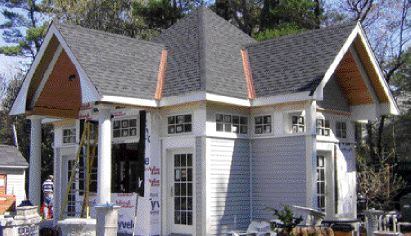Building a Strong Cathedral Hip Roof , continued
Accurate Framing
We framed the walls with 2x6s on 16-inch centers, topped by a single plate. To ensure that we wouldn’t be struggling to fit the heavy, 20-foot-long double LVL hip rafters, we took great care to square, plumb, and brace the four supporting corners to tight tolerances. The main square of the building was interrupted on three sides by the ells, so we stretched string lines from corner to corner across the gaps and left them in place for constant reference against possible movement. We set the lines on 2-by offset blocks inside the top plates and used a 2-by block as a feeler gauge to check the alignment.
While waiting for the steel brackets to be delivered, we went ahead and packed the plate between bracket locations with plywood to accommodate the thickness of the steel. After wrestling the steel into place, we installed a second 2×6 top plate over the assembly, first tracing the bolt-hole locations onto the plates and predrilling them for lag screws. We then used 3 1/2-inch-long lags to tie the wood and steel layers together.
Restrained by the steel brackets at the corners, the structural hips bear against one another at the peak and need no further means of support. Supporting valley rafters running from top plate to hip rafter hold up the small ell gables.
To work comfortably at the roof peak, which was 21 feet above the deck, we set up pipe staging inside the building. That involved pulling the temporary spring braces on the walls. We were pleased to find that the steel braces held the walls perfectly plumb throughout the roof framing process.
We used double 1 3/4-by-12-inch LVL hips, following the computer-engineered framing plan supplied by our lumber distributor. Each hip received a birdsmouth cut at the heel and a square-faced plumb cut at the ridge. The hips butted against a 4×4 nailing block at the ridge. In addition to carrying the 2×12 rafters, each hip provided support for the ells’ valley rafters. We framed each of these ell roofs with a combination supporting and supported valley.
The tall walls allow for a generous overhang without cramping the tops of the windows below. V-crimped copper valleys and copper stacks are both durable and elegant.
Hot Roof
Venting a hip roof is problematic because most of the rafter bays terminate against the hip rafter and not at the ridge, leaving no practical means of carrying air through from the eaves. We avoided the entire issue by blowing in Icynene foam insulation, creating an unvented “hot roof.”
Typical for our region, we applied 1×3 furring strips on 16-inch centers to the underside of the rafters in preparation for plaster board. With all the angles on this ceiling, the plasterer didn’t mind not having any collar ties to cut around, and the clients are pleased with the final results. It’s been over six months since completion, and there hasn’t been a single crack in the finish. It appears that the bracing works just as we intended it to.
Complex roofs are difficult to vent properly, so the author opted for an unvented “hot roof,” using spray-in-place Icynene insulation to prevent moisture-transport problems.
David West owns Meadowview Construction in Haverhill, Mass.
